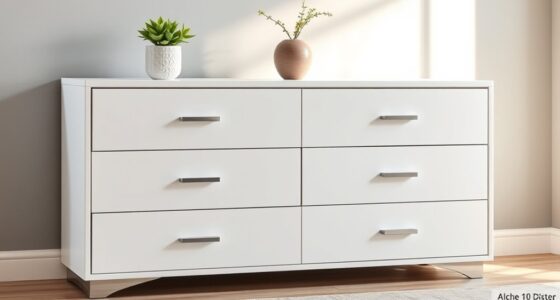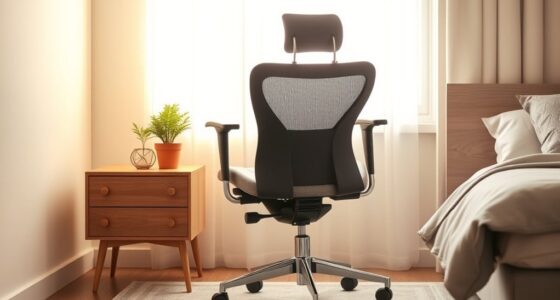To enhance your bedroom with vintage and upcycled furniture, combine restored pieces like a painted dresser with new hardware, or transform old doors into headboards for a unique touch. Use sustainable materials such as reclaimed wood and eco-friendly finishes for sustainable charm. Personalize your space by upcycling items into creative storage solutions or decorative accents. Embrace the blend of history and creativity, and discover simple projects that can make your bedroom truly stylish and eco-conscious.
Key Takeaways
- Incorporate vintage furniture with modern touches through painting, re-staining, or updating hardware for a fresh yet nostalgic look.
- Use reclaimed or sustainable materials to create eco-friendly upcycled pieces like headboards or storage solutions.
- Transform old furniture into personalized decor items, such as turning dressers into bedside tables or antique doors into headboards.
- Mix vintage and upcycled furniture with contemporary pieces to achieve a stylish, character-rich bedroom aesthetic.
- Restore and seal surfaces to preserve original details while ensuring durability and easy maintenance in daily use.

If you’re looking to add character and charm to your bedroom, vintage and upcycled furniture are perfect choices. They bring a unique aesthetic that blends history with creativity, transforming your space into a cozy, stylish retreat. One of the key aspects of working with vintage or upcycled pieces is understanding restoration techniques. These techniques allow you to revive old furniture, preserving its original beauty while guaranteeing it remains functional and durable. Sanding, staining, and sealing are common steps to refresh worn surfaces, remove imperfections, and protect the piece for years to come. Sometimes, a simple repaint or new hardware can markedly update an item, giving it a fresh look without sacrificing its vintage charm. The goal is to strike a balance—maintaining the piece’s character while making it suitable for everyday use.
Revive vintage furniture with sanding, staining, sealing, and subtle updates for lasting charm and functionality.
In addition to restoration techniques, choosing sustainable materials plays an essential role when working with vintage and upcycled furniture. Many pieces are crafted from solid wood, which is durable and eco-friendly compared to synthetic alternatives. By opting for furniture made from sustainable materials, you reduce your environmental footprint and support environmentally responsible manufacturing practices. Reclaimed wood, for instance, not only adds aesthetic value with its natural imperfections and weathered finish but also contributes to reducing deforestation. When upcycling, you might also incorporate eco-friendly paints and finishes, such as low-VOC or natural oils, that are healthier for you and the environment. This conscious approach ensures your furniture choices align with sustainable living principles, making your bedroom both stylish and eco-conscious.
Upcycling offers a creative avenue to customize your furniture, giving old pieces a new purpose. For example, turning a vintage dresser into a unique storage unit or repurposing an antique door as a headboard allows you to infuse personality into your space. The process often involves minimal materials and energy, emphasizing resourcefulness and sustainability. Whether you’re stripping paint to reveal the original wood grain or adding a modern twist through color and hardware, upcycling encourages personal expression while honoring the history of each piece. Plus, working with sustainable materials and mastering restoration techniques not only extends the life of furniture but also reduces waste, making your bedroom decor more environmentally friendly.
Ultimately, vintage and upcycled furniture provide a beautiful, eco-conscious way to craft a bedroom that’s both functional and filled with character. By employing thoughtful restoration techniques and choosing sustainable materials, you create a space that’s uniquely yours—timeless, environmentally responsible, and full of charm.
Frequently Asked Questions
How Do I Clean and Maintain Vintage Furniture?
To clean and maintain vintage furniture, start with gentle antique cleaning by dusting regularly with a soft cloth. Use a damp cloth for light dirt, avoiding harsh chemicals that can damage the finish. For furniture preservation, apply a high-quality wax or polish periodically to protect the surface. Always test cleaning products on a small area first, and handle your vintage pieces with care to keep them looking beautiful for years to come.
What Are the Best Paint Options for Upcycled Furniture?
You should choose chalk paint for a matte finish, milk paint for a vintage look, or latex paint for durability. Consider paint finishes like matte, satin, or gloss to match your style, and pick color choices that enhance your furniture’s charm. For a shabby chic vibe, opt for soft pastels, while bold hues make a statement. Always prep well and seal your paint for lasting beauty and protection.
How to Ensure Vintage Furniture Is Structurally Sound?
To guarantee vintage furniture is structurally sound, start with a thorough antique restoration. Check for loose joints, cracked wood, or weakened areas, and reinforce them with appropriate adhesives or screws. You should also replace any damaged parts, ensuring the piece maintains its structural integrity. Regularly inspect your furniture for signs of wear or deterioration, and address issues promptly to keep your vintage piece sturdy and beautiful for years to come.
Can Upcycled Furniture Be Customized for Modern Decor?
Absolutely, upcycled furniture can be customized for modern decor to a jaw-dropping degree. You can effortlessly transform it into a stunning centerpiece that perfectly matches your style, from sleek minimalist to bold eclectic. With some paint, new hardware, or creative refinishing, you make decor customization look like child’s play. So go ahead—integrate your unique style and turn upcycled pieces into modern masterpieces that leave everyone in awe!
What Safety Precautions Are Needed When Restoring Furniture?
When restoring furniture, you need to prioritize safety by always wearing protective gear like masks, gloves, and goggles to shield yourself from dust, chemicals, and splinters. Make certain of good ventilation safety by working outdoors or in a well-ventilated area to avoid inhaling fumes from paints, stains, or adhesives. Keep your workspace clean, follow manufacturer instructions, and dispose of waste properly to prevent accidents and health hazards.
Conclusion
By choosing vintage and upcycled furniture, you not only add unique charm to your bedroom but also support sustainable living. Did you know that furniture recycling reduces waste by up to 70%? This means your stylish, eco-friendly choices can make a real difference for the planet. So go ahead, embrace these creative ideas—your bedroom will be more beautiful, and you’ll be helping preserve the environment for future generations.









